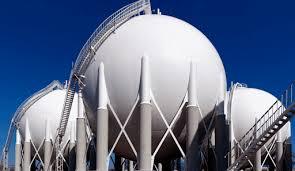Hydrogen Storage Tank Market Overview Reveals Expanding Scope Across Key Industries

The global hydrogen storage tank market is witnessing unprecedented momentum as hydrogen gains recognition as a crucial component in the transition toward clean energy. From powering vehicles to fueling industrial applications, hydrogen is increasingly in demand, and efficient storage solutions—particularly high-performance tanks—are critical for enabling safe and scalable hydrogen usage. This overview outlines the market’s structure, key segments, and major developments defining the future of hydrogen storage.
Market Definition and Role in Hydrogen Economy
Hydrogen storage tanks are pressure vessels or containment systems designed to safely store hydrogen gas or liquid for later use. They are essential for maintaining fuel supply in fuel cell electric vehicles (FCEVs), transporting hydrogen to end-users, and serving as a buffer for renewable energy storage systems.
The tanks must meet high standards of durability, pressure resistance, and safety—especially in mobile or high-capacity industrial settings. As hydrogen becomes a cornerstone of decarbonization, these tanks are increasingly used across a wide spectrum of sectors including mobility, power generation, aerospace, marine, and industrial processes.
Types of Hydrogen Storage Tanks
The hydrogen storage tank market includes several tank types classified by design and material composition:
-
Type I: Made entirely of metal (usually steel or aluminum), these are the heaviest and least expensive. Used mostly for stationary applications.
-
Type II: Metal liner with a composite wrap; lighter than Type I and offers better performance at moderate pressures.
-
Type III: Composite tanks with a metal liner; widely used in mobile applications for their balance of strength and weight.
-
Type IV: Fully composite tanks with a plastic liner; offer the highest weight savings and are commonly used in FCEVs and aerospace.
-
Type V (Emerging): Fully composite tanks without a liner, still in the R&D phase, promising even higher performance and weight efficiency.
Each tank type serves a different market segment depending on pressure requirements, application, and cost considerations.
Applications Driving Market Demand
The increasing versatility of hydrogen has expanded its application base, creating robust demand for storage tanks across the following areas:
-
Automotive Sector: FCEVs, especially in commercial fleets and buses, rely on lightweight Type III and Type IV tanks for onboard hydrogen storage.
-
Aerospace & Drones: Aerospace projects use ultra-lightweight tanks for long-endurance hydrogen fuel cell drones and aircraft.
-
Industrial Applications: Hydrogen is used in refining, chemical manufacturing, and metallurgy, requiring stationary tanks for bulk storage.
-
Renewable Energy Integration: Tanks store hydrogen produced via electrolysis using solar or wind energy, acting as energy buffers for grid management.
-
Maritime and Rail: Hydrogen-powered ships and trains are emerging, fueling the need for mobile high-capacity hydrogen storage.
This wide adoption range is transforming hydrogen storage tanks from niche components to vital energy infrastructure assets.
Key Market Drivers
Several factors are contributing to the rapid growth of the hydrogen storage tank market:
-
Global Decarbonization Efforts: Governments and corporations worldwide are investing in hydrogen to meet carbon neutrality goals, creating a strong push for supportive infrastructure like tanks.
-
Rise of Hydrogen-Powered Mobility: As an alternative to electric vehicles, hydrogen-powered mobility solutions are scaling up, especially in sectors where batteries fall short.
-
Expansion of Hydrogen Infrastructure: The development of refueling stations, pipelines, and centralized production hubs is increasing the need for reliable and efficient hydrogen storage systems.
-
Technology Advancements: Improved composite materials, AI-based monitoring systems, and modular tank designs are enhancing tank performance, safety, and adaptability.
These factors are collectively positioning hydrogen storage tanks as indispensable components in the emerging hydrogen economy.
Regional Overview
-
Asia-Pacific: Leading the market with strong government support in countries like Japan, China, and South Korea, focusing on hydrogen mobility and infrastructure.
-
Europe: Robust investments through the EU’s Hydrogen Strategy and funding for green hydrogen projects are fueling tank demand.
-
North America: Particularly in California and Canada, policy support and pilot programs are encouraging market expansion.
-
Middle East & Africa: Gaining prominence as green hydrogen producers and exporters, initiating projects that require large-scale storage capacity.
Each region presents unique growth opportunities shaped by local policies, industrial activity, and technological readiness.
Future Outlook
The future of the hydrogen storage tank market is highly promising. With hydrogen poised to play a central role in global energy systems, demand for flexible, safe, and cost-effective storage solutions is set to soar. Innovations in tank materials, real-time safety monitoring, and integration with smart grids will further accelerate adoption.
As commercial-scale hydrogen projects multiply—from mobility and transportation to grid storage and green manufacturing—the role of hydrogen tanks will evolve from being supportive infrastructure to a strategic enabler of energy resilience and sustainability.
Conclusion
This overview underscores the vital position of hydrogen storage tanks within the global energy transition. As hydrogen continues to replace fossil fuels across critical applications, the market for storage tanks is expanding in scale, scope, and sophistication. Companies investing in this space today will be shaping the hydrogen economy of tomorrow.
- Art
- Causes
- Crafts
- Dance
- Drinks
- Film
- Fitness
- Food
- Games
- Gardening
- Health
- Home
- Literature
- Music
- Networking
- Other
- Party
- Religion
- Shopping
- Sports
- Theater
- Wellness


